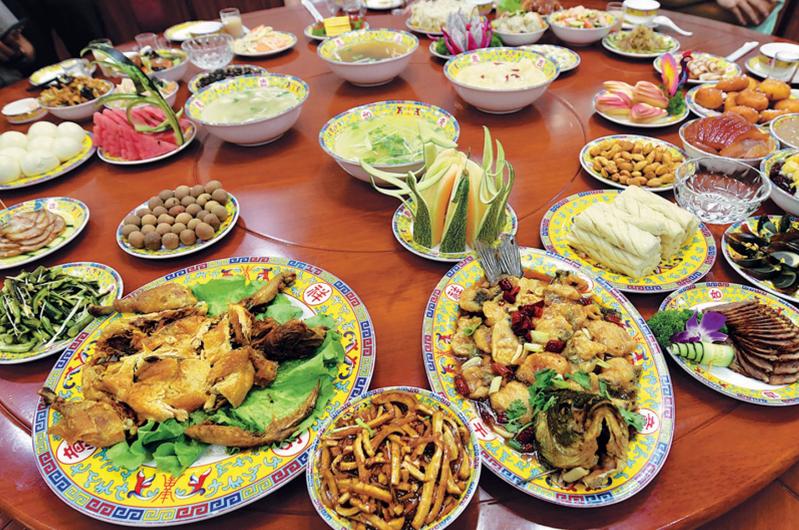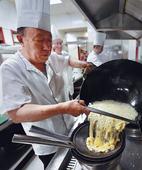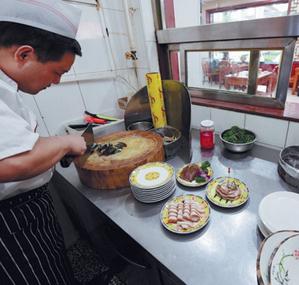A traditional regional banquet has remained popular throughout the centuries, Yang Feiyue and Sun Ruisheng report in Yangquan, Shanxi.
 The sanba feast featuring 36 dishes is served in some parts of Shanxi's Jinzhong, as well as in Hebei province's Jingxing county. (WEI XIAOHAO / CHINA DAILY)
The sanba feast featuring 36 dishes is served in some parts of Shanxi's Jinzhong, as well as in Hebei province's Jingxing county. (WEI XIAOHAO / CHINA DAILY)
Residents in Pingding county in North China's Shanxi province have long considered the sanba banquet to be the highest display of respect and hospitality toward friends.
The feast features 36 dishes and can be traced to the Song Dynasty (960-1279).
A fresco from the 1102-06 period discovered in Pingding in 1972 depicts the feast being cooked and eaten.
Everything involved in the feast is more complicated than with typical local dishes, from rawmaterial selection to knife work and cooking
Zhao Yongsheng, senior chef at Pingding Laohao Restaurant
The royal families of the Qing Dynasty (1644-1911) began to enjoy the banquets after empress Dowager Cixi (1835-1908) raved about the feast during her visit to Pingding's Xijiao village in 1900.
The feast is now served in most parts of Yangquan, Shouyang and Xiyang counties in Shanxi's Jinzhong, as well as in Hebei province's Jingxing county.
Traditions surrounding the sanba banquet have survived the centuries.
Eight dishes of seasonal snacks, including melon seeds, raisins and cantaloupe, are served first.
Then, eight cold dishes ensue, before the rest of the hot dishes and soups are presented.
"The hot dishes aren't brought out until customers feel like they've had enough to drink," says Zhao Yongsheng, a senior chef at Pingding Laohao Restaurant, which focuses on distinctive local cuisine.
 Zhao Yongsheng, 72, a fourth-generation inheritor of sanba banquet, has been cooking the feast all his life. (WEI XIAOHAO / CHINA DAILY)
Zhao Yongsheng, 72, a fourth-generation inheritor of sanba banquet, has been cooking the feast all his life. (WEI XIAOHAO / CHINA DAILY)
Certain dishes are matched and presented simultaneously to balance flavors.
"One big sweet dish is usually matched with two small sweet dishes, and the same with the salty ones," Zhao says.
Zhao has been cooking local dishes since the early '60s.
" The sanba feast wasn't as prevalent then as it is today," the 72-year-old recalls.
"It was only eaten on special occasions, such as when treating sons-in-law or celebrating elderly people's birthdays."
Food was scarce then. So, most ingredients were preserved through drying, especially seafood.
"They have to be preprocessed-for instance, by soaking in water," Zhao says.
Consequently, guests must book the banquet at least a day in advance.
At the beginning of his career, Zhao could prepare the feast only three to five times a month.
"Most of the time, I helped out local households with my teacher, since it was then cheaper for locals to make (the feast) at home than to order it at restaurants," Zhao says.
He watched and learned the processes, and started to practice at a collectively owned restaurant he worked for.
It took him about three years to acquire the skills.
"Everything involved in the feast is more complicated than with typical local dishes, from raw-material selection to knife work and cooking," he says.
 A chef at Pingding Laohao Restaurant prepares cold dishes for a sanba banquet. (WEI XIAOHAO / CHINA DAILY)
A chef at Pingding Laohao Restaurant prepares cold dishes for a sanba banquet. (WEI XIAOHAO / CHINA DAILY)
Different dishes need different knife work related to style, cooking and eating, Zhao explains.
He continued working at the Laohao restaurant after retiring from the collectively owned restaurant in 2000.
Compared with the past, today's ingredients are fresher and more varied, and a wider range of seasonings is available.
"We now have more room to adapt to different tastes," Zhao says.
But most parts of the feast have preserved traditional basics, such as the number of dishes.
Ancient table etiquette is honored, although more elegant utensils are used.
" (Utensils) must be consistent in color and style, and feature classical patterns that herald auspicious symbolism," Zhao says.
Shanxi named Pingding's sanba feast as a provincial intangible cultural heritage in 2011, and Zhao was named a fourth-generation inheritor.
He leads 17 chefs, some of whom have worked with him for two decades, at Laohao restaurant.
People no longer only enjoy sanba banquets during special occasions.
So, the restaurant must work faster to serve the feast.
"We receive eight to 10 tables of guests a day," says Liu Xianping, a senior manager at Laohao.
"Many locals will simply come together to enjoy the feast, especially during weekends and holidays."
Since most guests know how the banquet should look and taste, Zhao says they must make sure everything is just right.
The team members who prepare the meals review one another's work to ensure the whole banquet is presented with consistent quality, he adds.
Zhao says he hasn't given too much thought to the future.
"I've been cooking the sanba feast all my life," he says.
"And I didn't want to change much."
Contact the writer through yangfeiyue@chinadaily.com.cn


